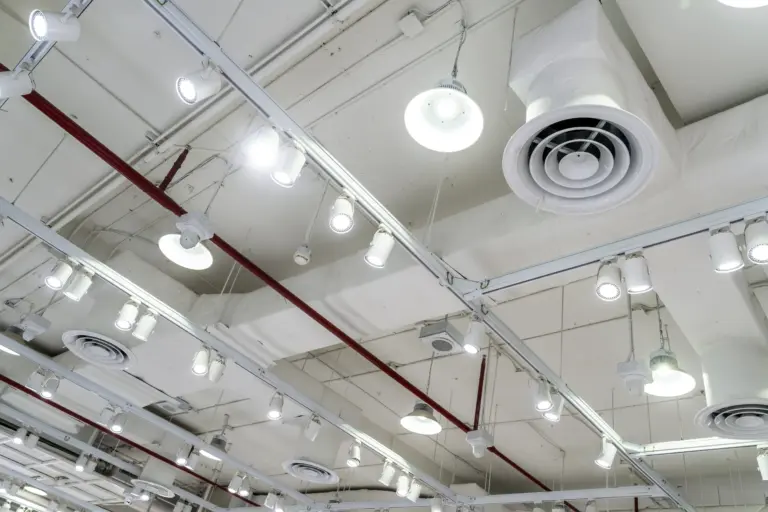
People have understood the need for ventilation for thousands of years. Prior to mechanical ventilation, humans relied on natural ventilation through architecture. Builders figured out, literally thousands of years ago, how certain building features and their placements improved air flow and modified indoor temperature.
NATURAL VENTILATION AND PASSIVE AIRFLOW
Humans have understood phenomena like wind pressure and the stack effect for a long time, even if they used different terminology and may not have had precise methods of measurement to gauge them.
The stack effect is essentially how air moves in and out of structures. The use of chimneys and flues is an example of people using the stack effect to direct air flow. Air's temperature impacts its buoyance. Hot air rises, which allows for the directed ventilation of smoke from fires.
The same effect can be used in reverse for cooling. A sunken structure with ventilation near the ceiling allows hot air to escape up and leave the cooler, heavier air near the floor. The warm air rising also reduces the air pressure at ground level, which results in a suction-like effect that pulls in air from outside through doors and windows.
The positive pressure at the top of a house and the negative pressure towards the ground is still relevant to HVAC technicians today. A contractor using a micromanometer can measure pressure difference between the top floors of a structure and the basement. The higher pressure of the upstairs means more hot air will be forced out of your second floor and attic.
Little holes at the corners of bent sheet metal and seams in inefficient attic ductwork is where you'll find the highest differentials in pressure. Heated air can be pushed out of shoddy ductwork and into attics where it can easily escape your home.
YAKHCHĀL
Some of the earliest examples of evaporative cooling were Yakhchāl, which were dome shaped buildings constructed first in ancient Persia. Below the dome was a subterranean storage space where food or even ice could be stored. They were built in desert areas where the dry air would accelerate evaporation.
Air would enter at the base and blow over a water source and down into up to 180,000 cubic feet of underground storage while heat would escape up the conical interior. These structures were constructed from a special water-proof mortar known as sarooj, which also doubled as highly efficient insulation.
Few ancient Yakhchāl structures still exist, but the word is used for "refrigerator" in modern Afghanistan, Tajikistan and Iran.
GREEK AND ROMAN IMPLUVIA
Ancient Greek and Roman homes sometimes had a complex drainage system known as an impluvium. Rainwater that fell or drained into courtyards would be gathered in impluvium – which was essentially a drain pool. The lining of the pool was either porous stone or the tiles were slightly separated. Underneath the pool would be layers of gravel and sand.
Underneath the impluvium would be an underground basement like room known as a cistern chamber. Water would filter through the impluvium's lining and gather in the cistern for later use as cooled, filtered drinking water.
The water could also be taken from the cistern and put in shallow pools in the home's atrium during summer months, where the water would evaporate and cool the home.
OTHER ANCIENT EVAPORATIVE COOLING TECHNIQUES
Ancient Egyptians would hang wet clothing across doors and windows so the air being sucked inside would be cooled by the damp fabric.
Many places in the Middle East also had windcatcher towers. These turrets had an open side that would face away from prevailing winds in an area. The difference in air pressure between each side of the turret caused air to be sucked down the turret opening, where it would be blown across a complex network of below-ground canals. The cooled air would then be sucked up into a home or building, creating a steady flow of cooled air.
In China, Tang Dynasty Emperor Xuanzong (AD 713 – AD 756) had a cool hall constructed that used a system of water-driven rotary fans to spray water from fountains through the hall. The effect was essentially the same as electric-driven evaporative coolers (swamp coolers) today.
MODERN HEATING AND COOLING (MECHANICAL VENTILATION)
Artificial refrigeration methods were first pioneered in 1748 by Scottish professor William Cullen. The first recognizable and practical refrigerator was made by American inventor Jacob Perkins in 1834. By 1902, engineer Willis Haviland Carrier (yes, that Carrier) had invented the modern air conditioner.
The initial purpose of the air conditioner was to control humidity in a Brooklyn printing plant. By 1933 his new company, Carrier Air Conditioning Company of America, was manufacturing a consumer air conditioner that combined a belt-driven condensing unit, blower, an evaporator coil and controls.
Initially only commercial buildings could afford to install these early air conditioners. They became synonymous with movie theaters in the 1930s and '40s, which was a boon for the movie industry in that era.
Large mechanical evaporative coolers, often called swamp coolers, became affordable for homes and commercial buildings in the 1940s. They became the go-to for homes in warmer climates, especially those that were dry.
It wasn't until the 1950s and '60s that air conditioning became truly affordable for homeowners. Central air conditioning systems and HVAC setups we're familiar with today didn't become the norm until the 1970s.
KEEP YOUR WASHINGTON, D.C. HOME ON THE CUTTING-EDGE OF HEATING AND COOLING
Residents of the DMV who want to keep their heating and cooling systems working optimally, and those who are looking for a more efficient, better performing system, should call Vito Services at 301-315-6100 .
Vito Services has been providing plumbing, heating and cooling services since the early days in 1934. We're proud to still install and service all types of Carrier HVAC systems more than 80 years later.








